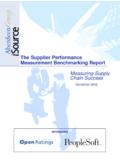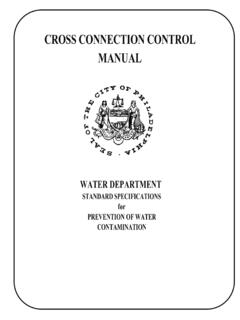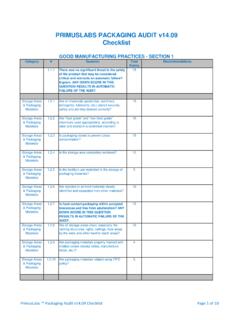Transcription of Creating sustainable relationships using the strengths ...
1 Ijtd_367 sustainable relationshipsusing the strengths , opportunities,aspirations and results framework,trust, and environmentalism:a research-based case studyJoseph Sprangel, Jacqueline Stavrosand Matthew ColeNew forms of organization development are moving from aclassical diagnostic perspective to a dialogic perspective. Thismove includes a focus on exploring positive states of organiz-ing, shared aspirations, and the design of preferred futures askey outcomes of a strategic change process. Training and devel-opment that applies the elements of the strengths , opportuni-ties, aspirations and results (SOAR) framework allows forstakeholders to engage in a dialogue that represents the wholesystem, and builds trust and environmental managementsystems that can positively impact supplier performance.
2 Inthis study, we examined the interrelationship between theSOAR framework, trust, environmental management systems,and supplier performance in respect of 71 program managersand customers from the Hass TCM Group, the largest chemicalmanagement services provider in North testing was carried out using correlationanalysis, multiple linear regression, correlation analysis andSobel s test for mediation. Our results support a combinedframework in which the SOAR framework can be used to buildtrust and pro-environmental behaviors to train suppliers todevelop collaborative relationships with customers.
3 Joseph Sprangel, Assistant Professor, Mary Baldwin College, 318 Prospect Street, Staunton, VA24401, USA. Email: Jacqueline Stavros, Associate Professor, DBA ProgramChair, College of Management, Lawrence Technological University, 21000 West Ten Mile Road, South-field, MI 48075-1058, USA. Email: Matthew Cole, Assistant Professor, PsychologyProgram Director, College of Arts and Sciences, Lawrence Technological University, Southfield, MI48075-1058, USA. Email: Journal of Training and Development 15:1 ISSN 1360-3736 2011 Blackwell Publishing sustainable relationships39 Introduction Corporations, because they are the dominant institution on the planet, must squarelyaddress the social and environmental problems that afflict humankind (Hawken, 1993,p.)
4 Xiiii). Hart (1997) addressed the economic and environmental impact of sustainabledevelopment: Whereas yesterday s businesses were often oblivious to their negativeimpact on the environment, and today s responsible businesses strive for zero impact,tomorrow s businesses must learn to make a positive impact (p. 68). The World Busi-ness Council for sustainable Development (WBCSD, 2008) defines sustainable devel-opment as forms of progress that meet the needs of the present without compromisingthe ability of future generations to meet their needs (p. 1). The WBCSD calls for anorganization development (OD) framework that supports a collaborative approach tosustainable development, uniting individuals, organizations, ideas and assets to benefitthe earth from its ecosystem to the needs of its diverse population (Business as anAgent of World Benefit, 2005).
5 One business model that integrates this OD frame-work is the Chemical Management Services (CMS) model shown in Figure 1. TheCMS model has resulted in both improved business economics and traditional chemical supply chain relationship involves conflicting incentivesbetween the supplier , who wants to increase chemical sales, and the customer, whowants to decrease chemical costs. The CMS model shifts the traditional customer supplier relationship from chemical-as-substance to that of chemical-as-service man-agement (Atkinson, 2004). This new chemical management model can contribute tosignificant cost reductions, decreased usage or substitution of chemicals harmful to theenvironment, less required labor, and more efficient chemical waste management.
6 Forexample, General Motors (GM) saves approximately 30 percent on average at eachfacility that implements the program (Atkinson, 2004). The program improved thecorporation s environmental performance, reduced costs and contributed to improvedshareholder nearly a decade of successful CMS implementation within GM, the Pew Chari-table Trust recognized CMS as an OD framework that puts environmental and socialconcerns on equal footing with profitability. According to research by Graham andBertels (2008), while there is increasing agreement that business needs to embracesustainability, research on sustainable development in the management field still pro-vides only limited guidance for how this should be done (p.)
7 58). This study proposesa framework on how sustainability can be accomplished by building trust and increas-ing environmental performance to address the question How can a CMS program betterTraditional relationshipConflicting incentivesService modelAligned incentivesCustomerThe CMS model: formerly conflicting incentives are now alignedChanging the supply chain model results in potential costssavings and environmental gainsSupplierWants todecreaseWants toincreaseMaterial(cost, volume)Lifecycle costs(material, labor, wastemanagement)CustomerWants todecreaseWants todecreaseServiceproviderFigure 1.
8 The chemical management services (CMS) model (from Kauffman Johnson, 2007).40 International Journal of Training and Development 2011 Blackwell Publishing implementation activities to achieve high levels of CMS supplier performance asmeasured by perceptions of program manager and customer supplier performance?Literature reviewSignificant barriers have been found to interfere with the implementation of an ODframework based on supplier performance, including a lack of trust between thesupplier and the customer (Fawcett & Magnan, 2004; Handfield & Bechtel, 2002; Montet al., 2006) and increased regulations for environmentalism (Bierma & Waterstraat,2000; Darnallet al.)
9 , 2008; Srivastara, 2007). Furthermore, an effective CMS programrequires the need to understand and negotiate diverse interests, real and otherwise, ofits stakeholders to implement the best CMS improvement initiatives. This literaturereview highlights the independent variables of the strengths , opportunities, aspirationsand results (SOAR) framework, trust and environmental management systems (EMS),and their effect on the dependent variable, supplier SOAR framework definedFigure 2 displays an illustration of the SOAR framework to utilize in CMS implemen-tation (Stavros & Saint, 2009; Stavroset al.
10 , 2007). SOAR is a profoundly positive frame-work for strategic thinking, dialoguing and analyzing. The framework allows a person,team, or organization to create a strategy and/or strategic plan to construct its futurethrough collaboration, shared understanding, and a commitment to action , such as Interface, Inc., 3M, Green Mountain Coffee Roasters, TrilliumAsset Management, John Deere, Calvert Group, and many others, are concluding thatcreating sustainable business value emerges when organizations embrace a wholesystem perspective. This multiple stakeholder perspective engages a business model orCoreplanningteamStakeholderidentificat ionInternalcapabilitiesanalysisCocreatev aluesvisionmissionStrategy andstrategicinitiativesGoals andobjectivesInitiateInquireintostrength sImaginetheopportunitiesInnovateto reachaspirationsImplementto achieveresultsExternalrealitiesanalysisT acticalplans andprogramsSystemiccontinuousimprovement PotentialoutcomesandinnovationsSOAR frameworkFigure 2: The strengths , opportunities, aspirations and results (SOAR) framework and the5-I approach (from Stavros & Saint, 2009).




